When you think about General Motors, you think about decades of horsepower, torque, and engines that defined generations.
GM built everything from silky-smooth V16s to rowdy small-blocks, and these powerplants didn’t just move cars – they shaped American culture.
Let’s count down the top 20 production engines ever made by GM, the ones that car guys still talk about at shows, in garages, and over diner coffee.
Chevrolet “Blue Flame” 235 Inline-6 (1953)
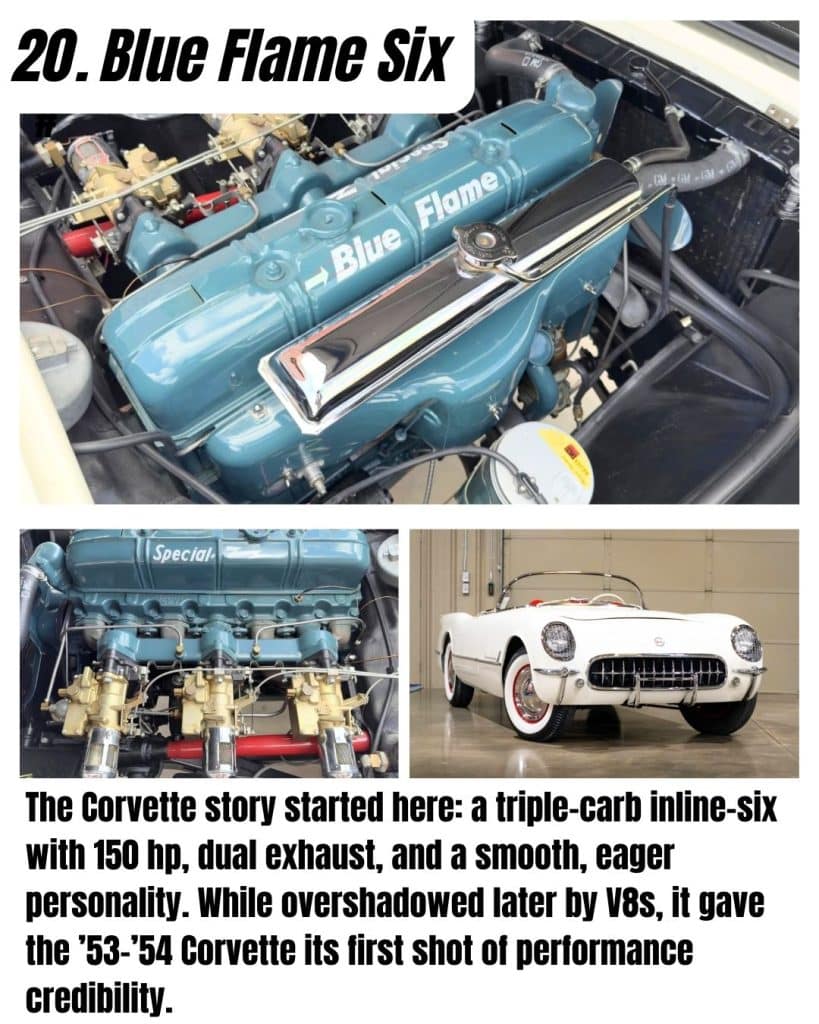
The Blue Flame Six was the powerplant in the first Corvette, and while it wasn’t a fire-breather like the V8s to come, it was somthing else in its day.
This 3.9L OHV straight-six featured a hot cam, higher compression and triple side-draft Carter carburetors on the Corvette, good for 150 hp – making it the most powerful six-cylinder Chevrolet had ever offered to that point.
Paired with a dual exhaust, the Blue Flame gave the 1953-54 Corvette a silky smooth soundtrack and respectable performance for a six.
It showed that Chevy was serious about sports cars even before the small-block V8 arrived, and it remains a strange piece of Corvette history.
Chevrolet 302 V8 (Z/28, 1967–69)
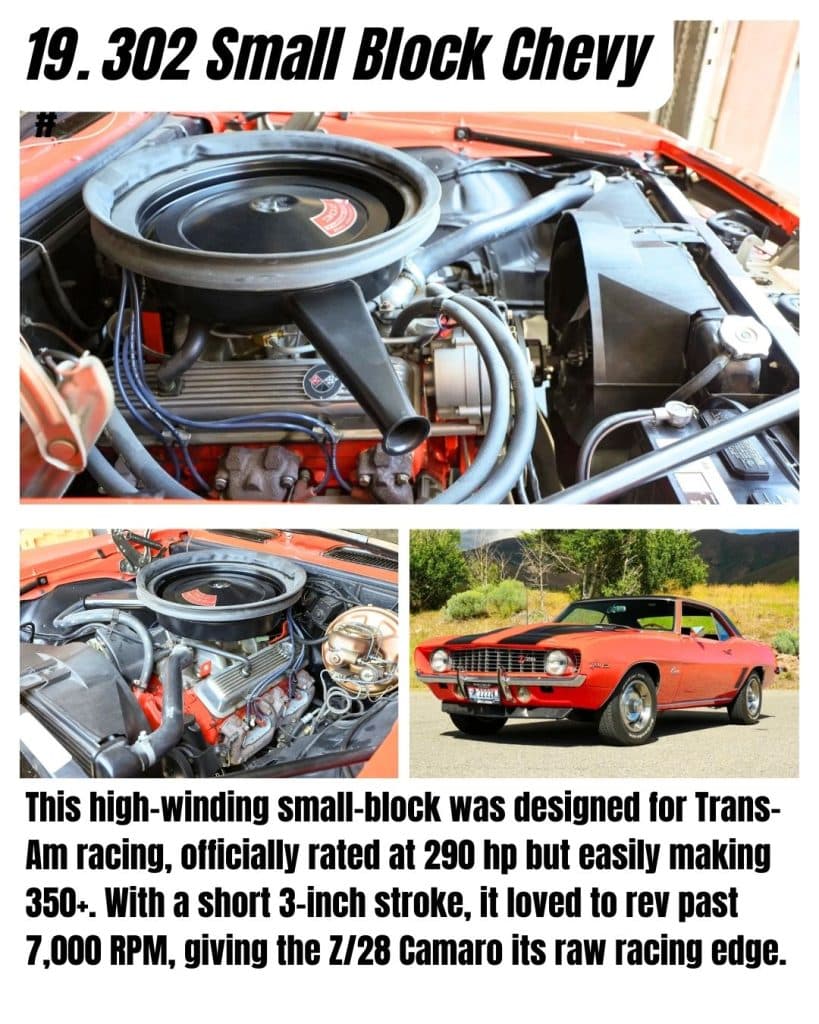
Engineered for Trans-Am road racing, Chevy’s high-revving 302 small-block (4.9L) was a screamer. It was officially rated at 290 hp (to satisfy class rules and insurance), but in reality the solid-lifter 302 made well over 350 hp and didn’t hit its stride until about 4,000 RPM.
With a short 3.0″ stroke and big-valve heads, it loved to rev past 7,000 RPMm which, in the nimble Camaro Z/28, meant it could run with much larger muscle cars on track.
The 302 V8’s unique combination of a broad torque curve and a frantic top-end made the ’67–’69 Z/28 Camaros true driver’s machines with a cult following.
Chevrolet 5.7L LT5 V8 (ZR-1, 1990–95)
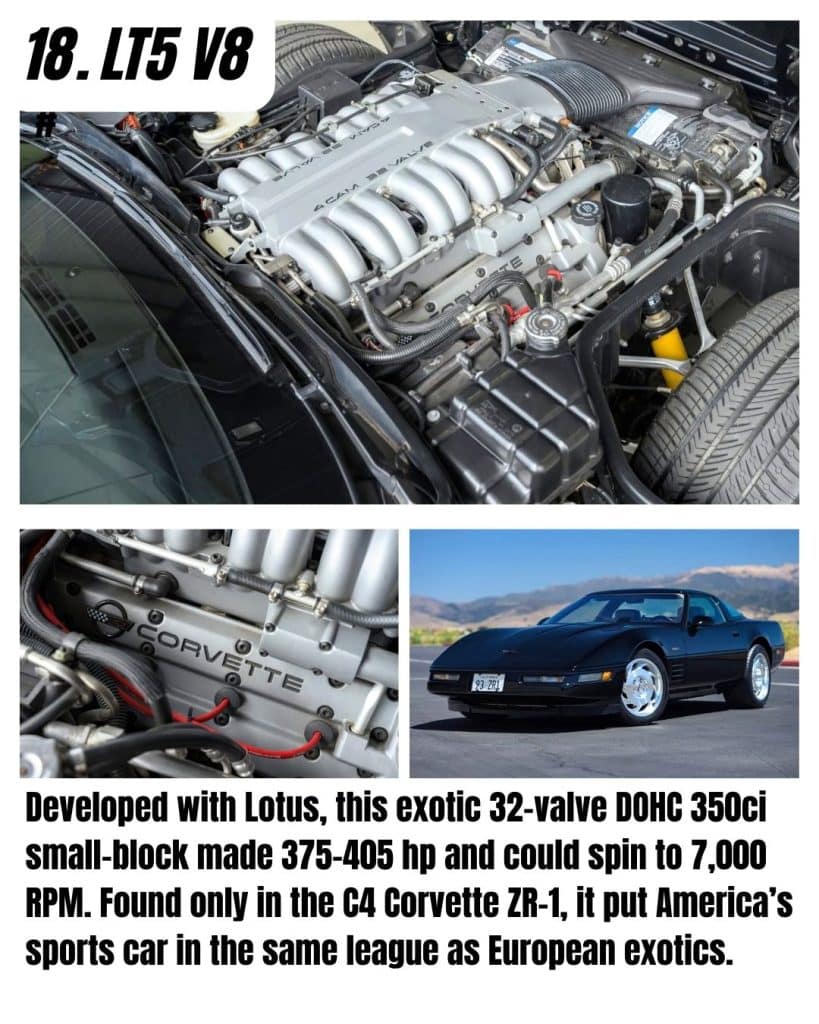
The LT5 was a radical departure for Chevrolet: a 350ci small-block developed with Lotus, featuring aluminum construction, dual overhead cams and 32 valves.
Used exclusively in the C4 Corvette ZR-1 “King of the Hill,” the LT5 produced an astonishing 375 hp (later 405 hp) and 370 lb-ft of torque, (a huge jump over the SBC of the early 90’s).
It had an innovative dual-runner intake system for a broad power band, and it could spin to 7,000 RPM with a ferocious top-end rush.
Until the C8 Z06’s flat-plane engine, the LT5 stood as perhaps the most exotic, high-tech engine ever in a Corvette, and it enabled the ZR-1 to stake a claim as America’s supercar in the early 90’s.
Cadillac 4.6L Northstar V8 (1993)
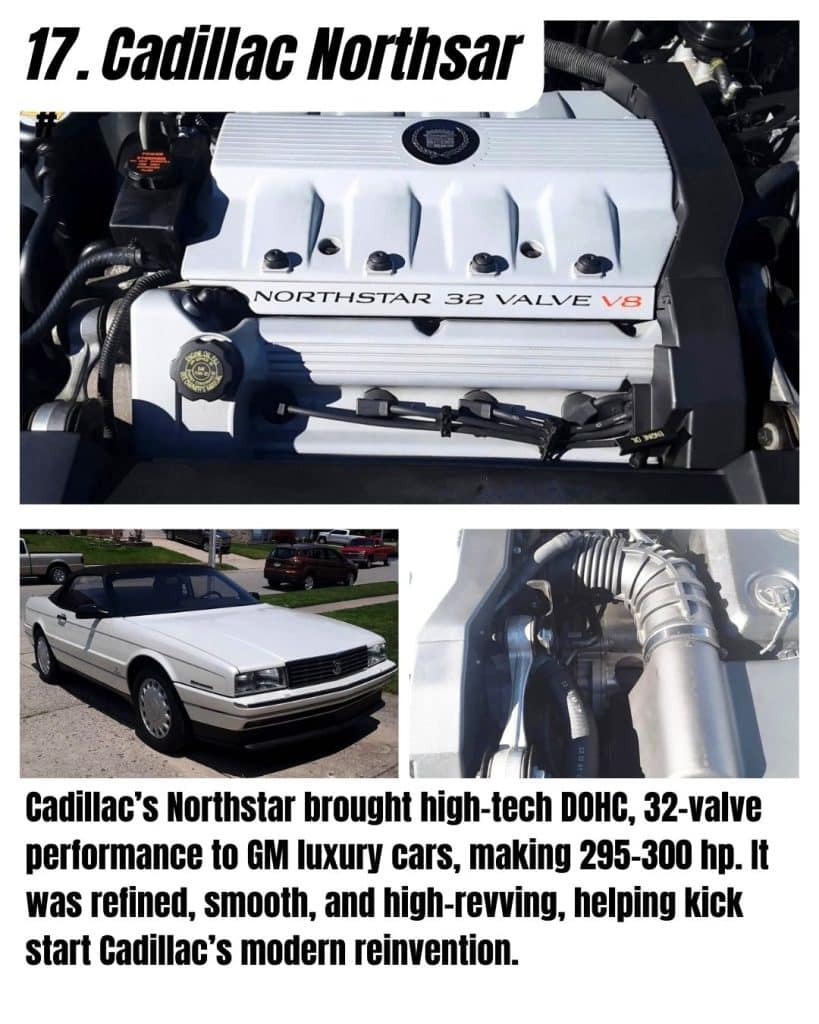
The Northstar brought modern multi-valve technology to Cadillac. This 4.6L DOHC V8, introduced in the 1993 Allanté and Eldorado, made around 295-300 hp (a ton of power for the time) with a smooth, high-revving character that contrasted with the old pushrod Cadillac.
It was lauded for its refined yet authoritative power delivery – silky smooth at cruise and eager at wide-open throttle – giving Cadillac a credible high-tech performance image in the ’90smotor-junkie.com.
The Northstar’s advanced design (32 valves, coil-on-plug ignition, etc.) earned it a unique place in GM engine lore despite later reliability woes.
Oldsmobile 215 V8 (Turbo Jetfire, 1962–63)
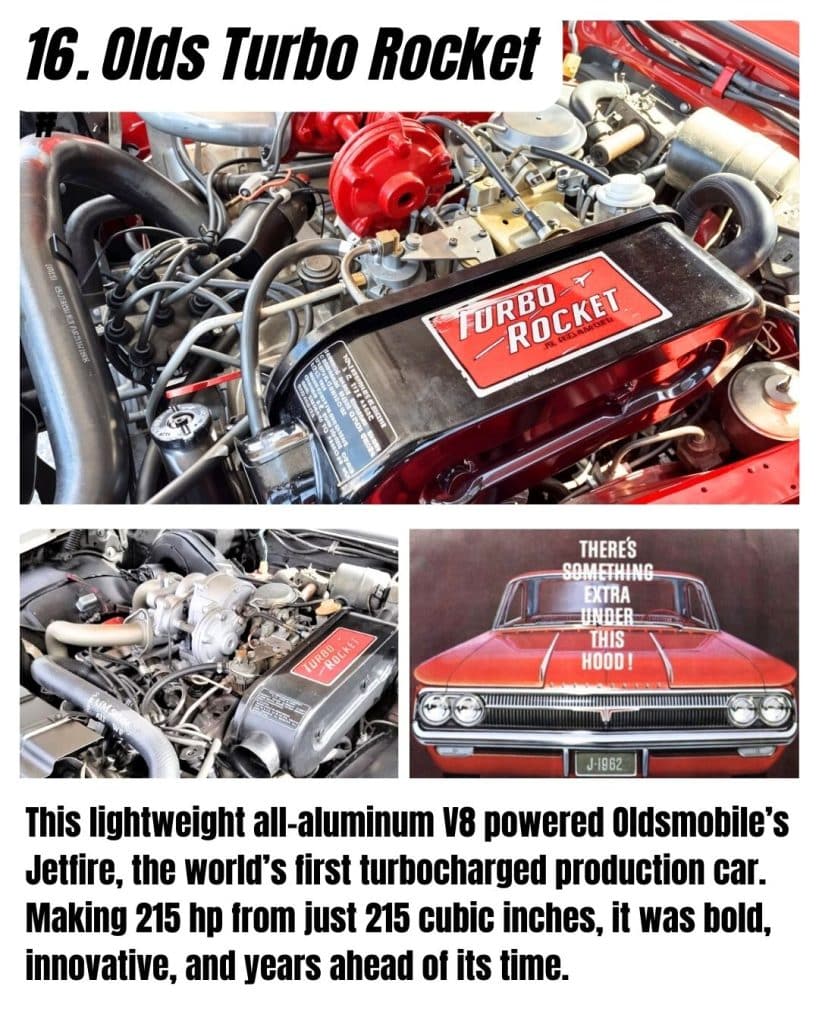
This little 215 cid (3.5L) V8 was an all-aluminum engine co-developed by Olds/Buick, so light that it later found a home in British sports cars. And, it became the heart of the world’s first production turbocharged car.
Oldsmobile’s 1962 F-85 Jetfire added a Garrett turbo to the 215, along with methanol/water injection, bumping output to 215 hp (one horsepower per cubic inch).
The Turbo Rocket V8 gave the compact Jetfire V8 performance on par with larger cars, proving GM’s early foray into turbocharging and lightweight design was bold if ahead of its time (though reliability issues meant the experiment was brief).
Pontiac 230/250 Inline-6 (OHC “Sprint” Six, 1966–69)
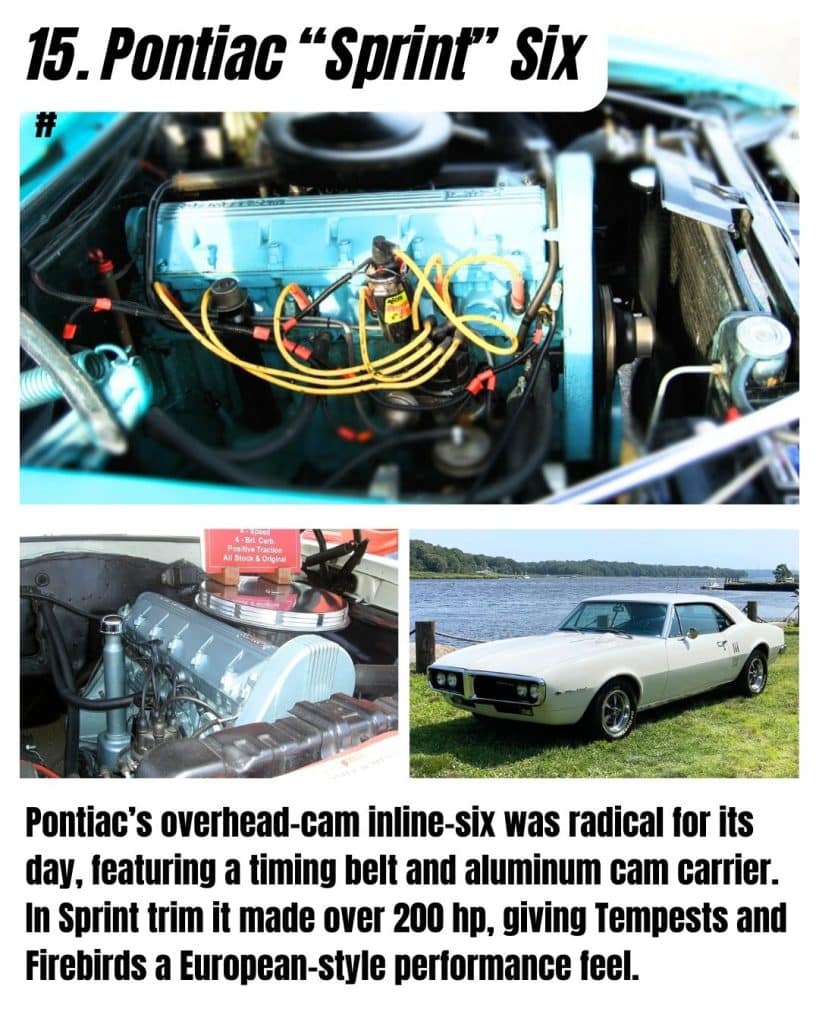
At a time when most Detroit engines were pushrod designs, Pontiac broke the mold with an overhead-cam straight-6.
This 3.8L/4.1L OHC six featured a fiberglass-reinforced timing belt (a novel idea then) and an aluminum cam carrier, truly advanced engineering for an American engine in 1966.
In high-output Sprint trim it packed a hotter cam and Quadrajet 4-barrel, making up to 215–230 hp. T
hat gave the Tempest/Firebird Sprint a surprisingly lively performance (and European flair) without a V8, though the design was sadly short-lived.
Cadillac 500 V8 (1970)

Topping out at a colossal 500 cubic inches (8.2 liters), Cadillac’s 500 was, and is, the largest production-car V8 in GM history.
In 1970 it produced a thunderous 400 hp and 550 lb-ft of torque (gross), all in effortless, low-RPM fashion to waft the big Eldorado along.
This engine wasn’t about quarter-mile times; it was about quiet, locomotive-like torque.
Nevertheless, hot-rodders later discovered the Cadillac 500 as an interesting swap candidate for its sheer size and stump-pulling twist.
Pontiac 455 V8 (Super Duty, 1973–74)
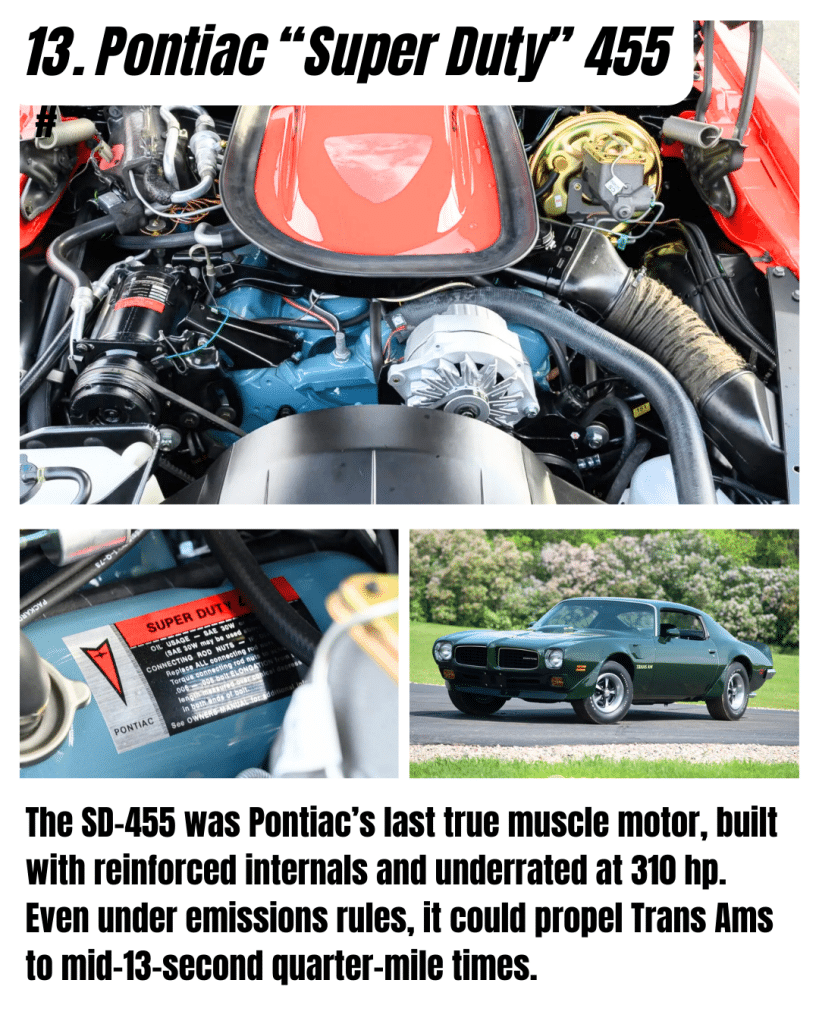
The 455 “Super Duty” was Pontiac’s last gasp of real muscle in the 1970s, arriving just as the era was ending.
This 455 had reinforced internals, high-flow heads, and was optimistically underrated at 290–310 net horsepower (about 360+ hp by 1970 standards).
In the 1973–74 Trans Am, the SD-455 could rip 13-second quarter-miles even with emissions controls, making it arguably the last true muscle-car engine of the classic era and a prized “last stand” among enthusiasts.
Buick 401/425 V8 (“Nailhead”, 1953–66)

Buick’s “Nailhead” V8 earned its nickname from its small, vertically oriented valves and unique pent-roof combustion chambers.
This design limited high-RPM breathing, but these engines produced mountains of torque – in fact, the Nailhead often exceeded 1 lb-ft of torque per cubic inch, exceptional for the era.
That smooth torque made Buick’s 401 and 425 V8s a force on the street (and a favorite for heavy luxury cars), and hot-rodders embraced Nailheads in the ’50s for their reliability and distinctive looks.
Pontiac 421 V8 (Super Duty, 1962–63)

Pontiac’s 421 Super Duty was a factory-built racing engine that ruled the drag strips in the early ’60s.
Stuffed into Catalinas and Tempests in limited numbers, this 6.9L V8 featured racing camshafts, dual quads, and fortifications throughout.
The result was a thunderous exhaust note and brutal acceleration that often eclipsed rival big-blocks – a “booming, authoritative” presence that symbolized Pontiac’s golden age in motors.
Chevrolet 409 V8 (1961–65)
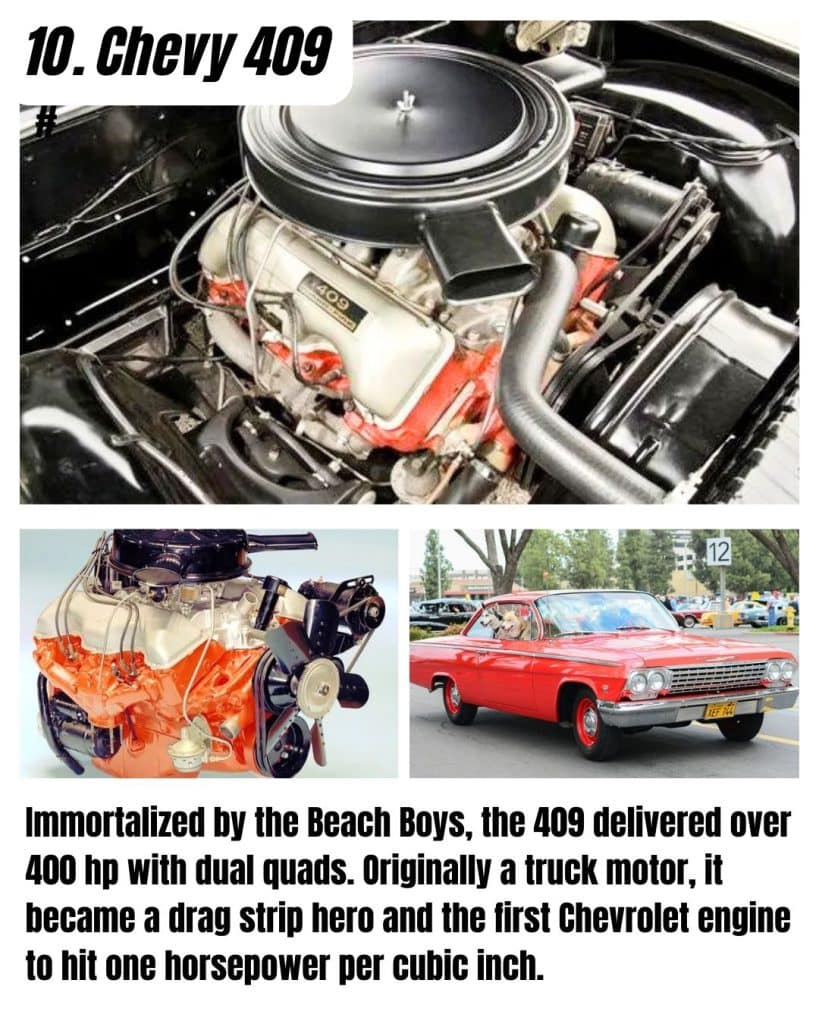
“She’s real fine, my 409!” Chevy’s 409 cubic-inch V8 became an early ’60s icon (not just for its Beach Boys pop-culture fame, but for its on-track dominance).
Initially a torque-heavy truck engine, the 409 was hopped up to over 400 hp with dual quads in 1962, achieving the magic 1 hp per cubic inch.
It promptly started putting Chevys in winner’s circles nationwide, from drag strips to NASCAR, before yielding to the 396 big-block in 1965.
Oldsmobile 303 V8 (“Rocket 88”, 1949)
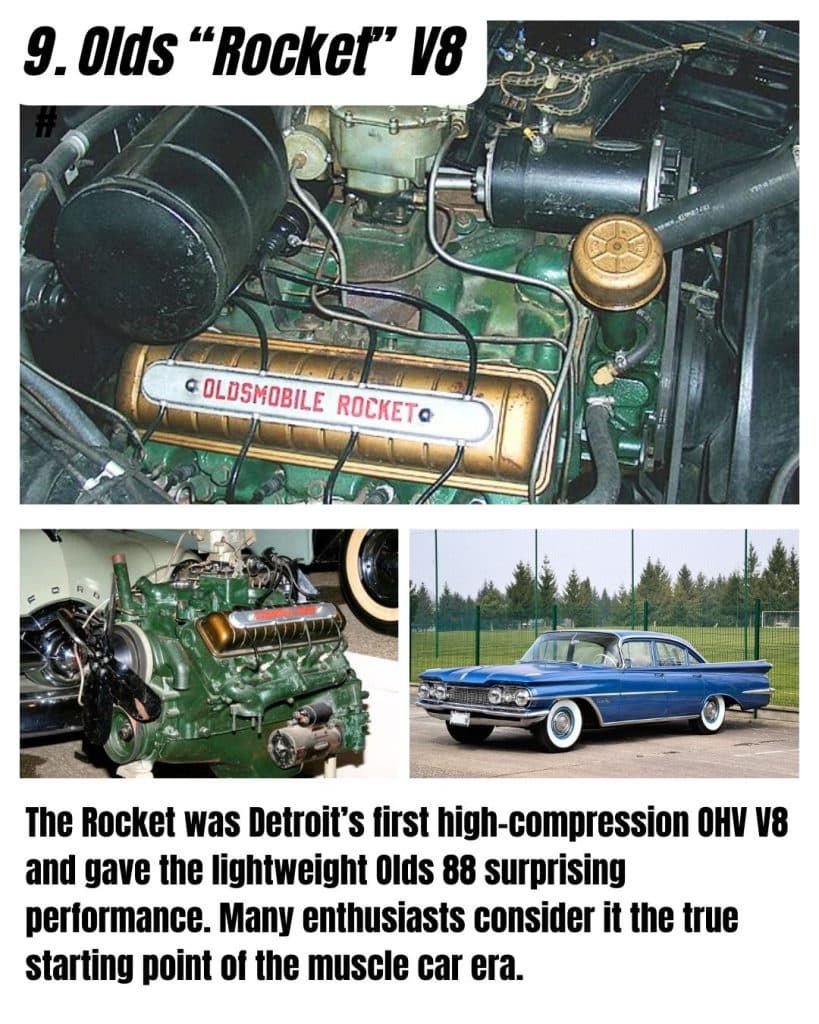
Oldsmobile’s 303 cid “Rocket” V8 was the first high-compression, overhead-valve V8 to hit American showrooms after WWII.
With 135 hp in the lightweight 1949 Olds 88, it delivered startling performance for the time – so much so that many consider the Rocket 88 the first true muscle car in spirit.
This engine’s success kicked off Detroit’s horsepower race, and the “Rocket” name became synonymous with Oldsmobile performance for decades.
Buick 3.8L/3800 V6 (1962–2000s)
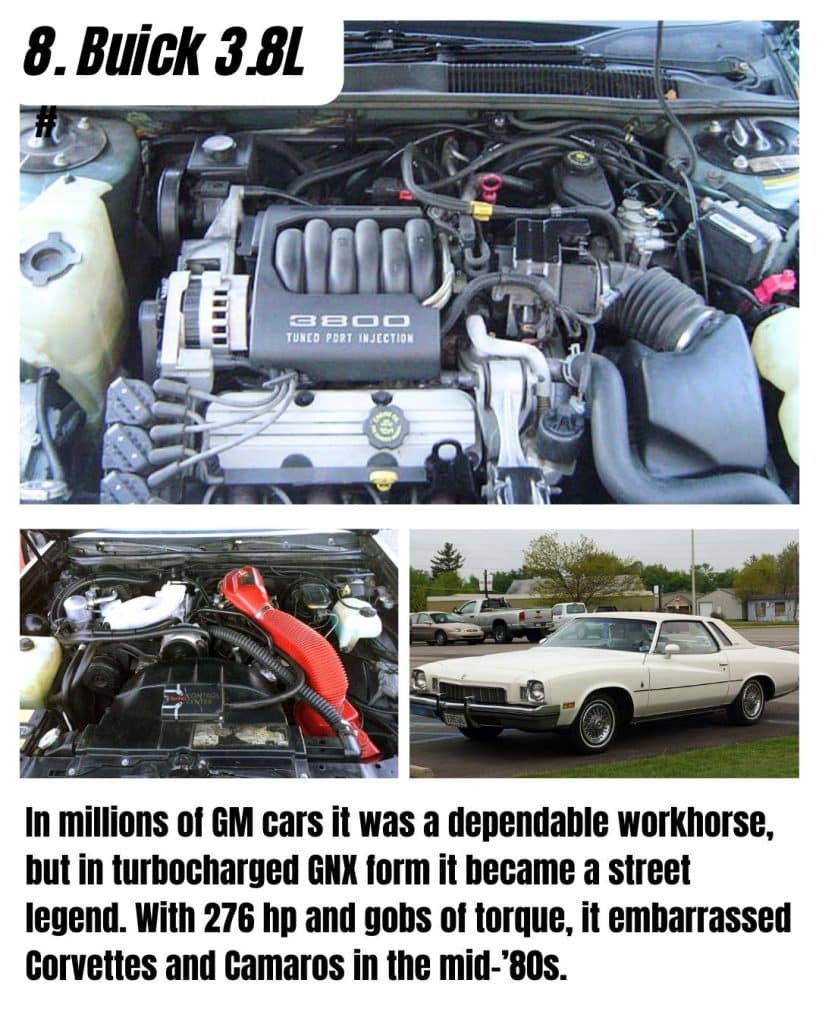
Buick’s 231-cubic-inch V6 gained a cult following both for performance and bulletproof reliability.
In turbocharged form, it powered the regal Grand National and GNX in the 1980s – sinister black Buicks that shocked the muscle car world by outrunning V8 sports cars (even embarrassing Chevy’s own Corvette) in a straight line.
Later, as the refined 3800 Series II, this V6 became known as an engine that “just wouldn’t die,” reliably powering millions of GM cars for hundreds of thousands of miles.
Cadillac 452 V16 (1930)
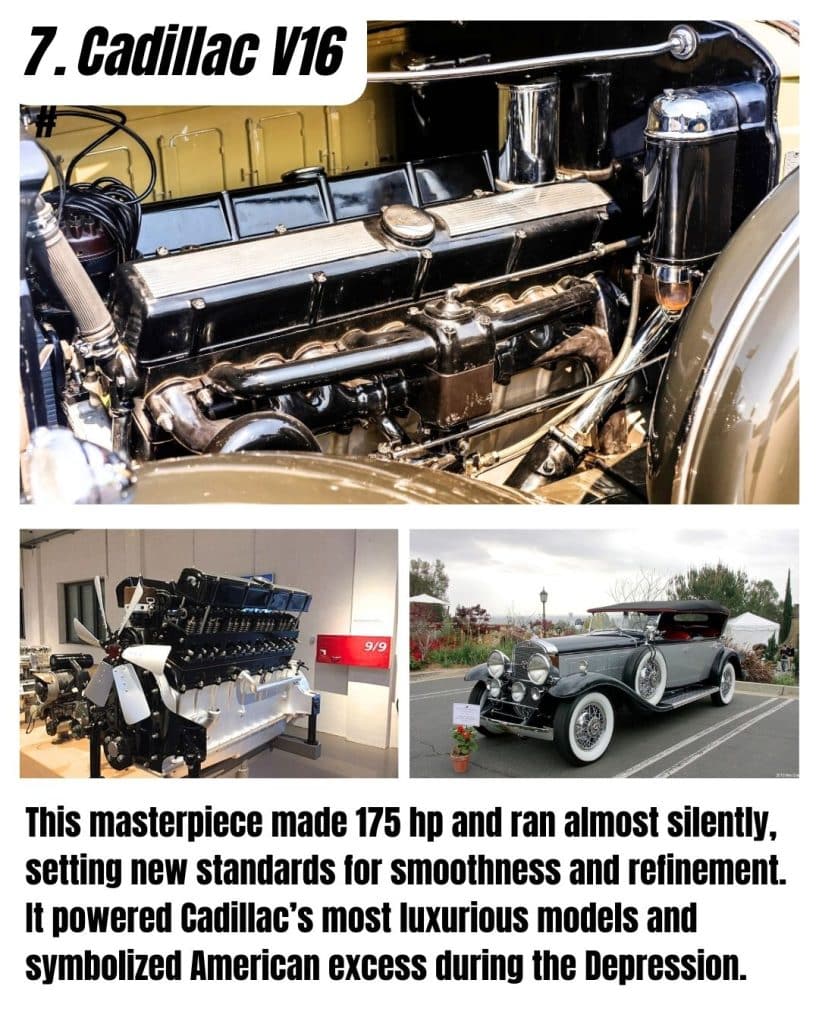
Cadillac’s original V16 was an engineering tour de force of the classic era.
This 452 cubic-inch V16 featured overhead valves and produced about 175 hp – modest on paper, but its silky-smooth, nearly silent operation was unmatched, and it delivered effortless torque.
Built for ultimate luxury cars, the mighty V16 became a symbol of 1930s American opulence and is now recognized as one of the finest prewar engines ever made.
Pontiac 389 V8 (Tri-Power, 1964)
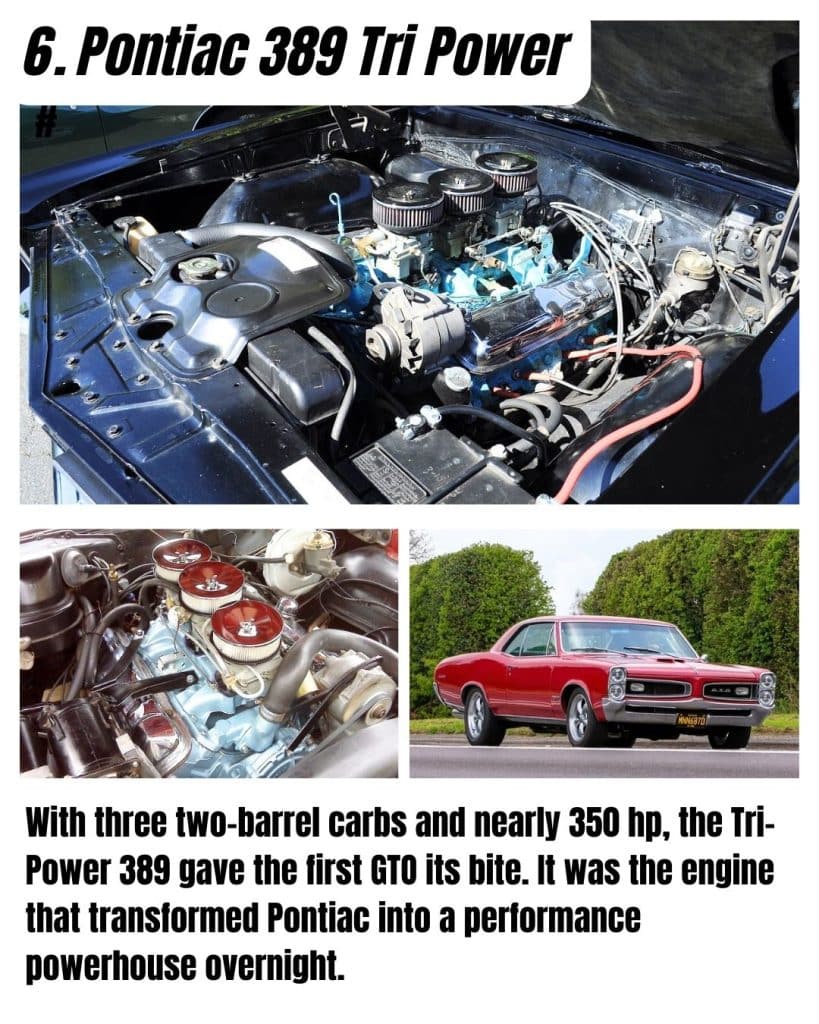
The 389 powered the 1964 Pontiac GTO, the car widely credited with igniting the 1960s muscle car era.
All ’64 GTOs carried this 6.4L V8 – rated 325 hp with a four-barrel, or up to 348 hp with the famous Tri-Power triple-carb setup.
Dropping this high-output 389 into a mid-size LeMans body created an overnight legend: the GTO could rip 0-60 and quarter-mile times that made Detroit realize the muscle formula’s potential.
Buick 455 V8 (Stage 1, 1970)
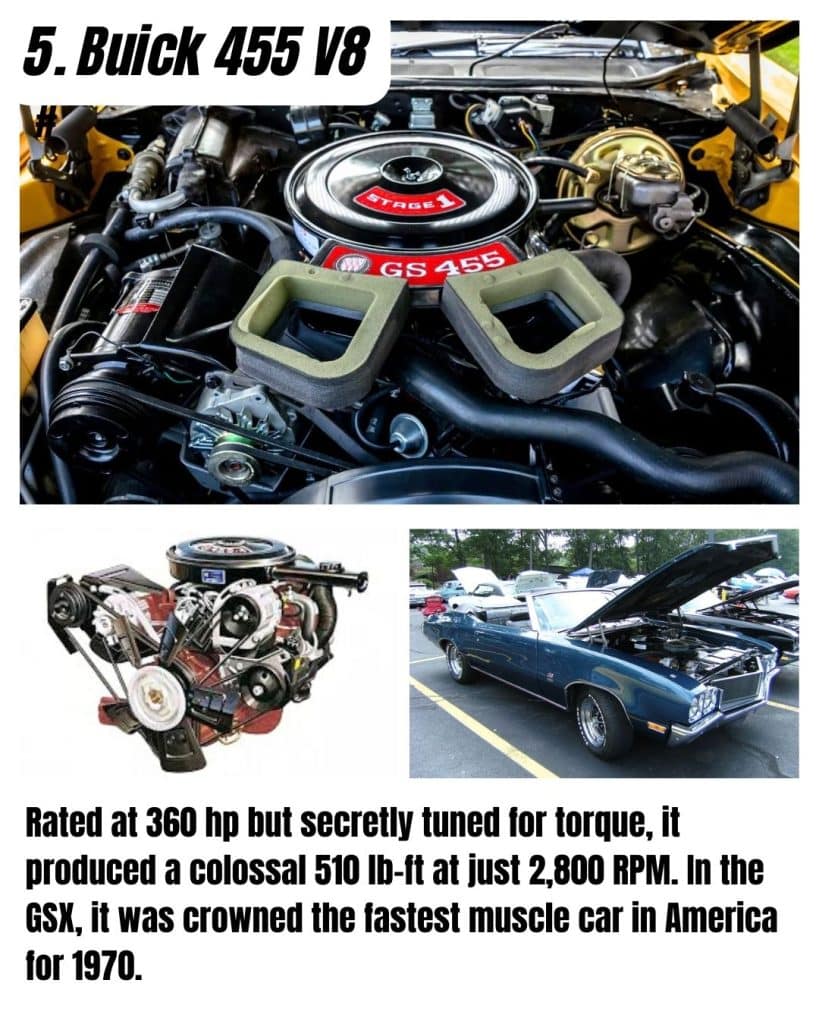
Buick’s Stage 1 455 was a 7.5L big-block with an underrated 360 hp factory rating, but its real claim to fame was torque – a pavement-wrinkling 510 lb-ft at just 2,800.
In the GSX and Gran Sport, the Stage 1 could outrun more heralded machines (it was crowned America’s fastest muscle car by some in 1970) thanks to this massive low-end punch and a factory tuning bias toward raw acceleration.
Chevrolet 427 V8 (L88, 1967–69)
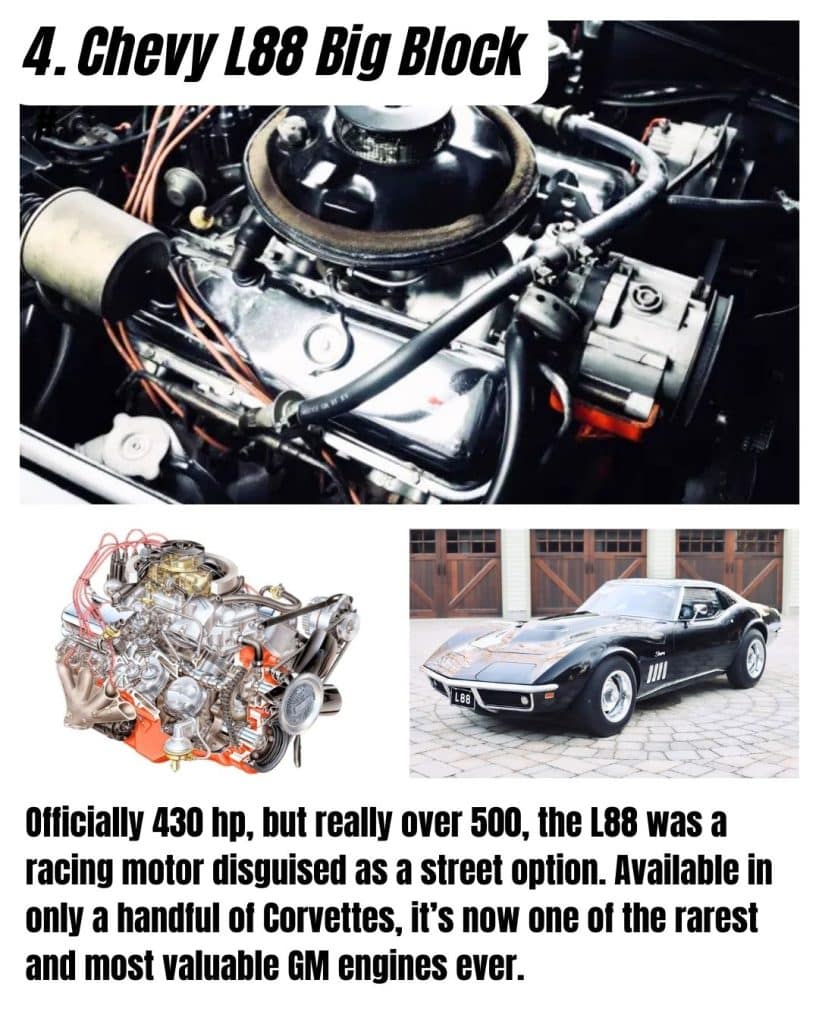
A racing-bred big-block, the L88 was a 7.0L V8 offered in late-’60s Corvettes with a factory rating of 430 hp, a number deliberately underrated by GM to discourage street use.
In truth, this high-compression, solid-lifter monster made well over 500 hp and came only with heavy-duty racing hardware.
Its thunderous roar and brutal performance made it a legend among muscle car engines and a coveted choice for collectors.
Chevrolet 454 V8 (LS6, 1970)
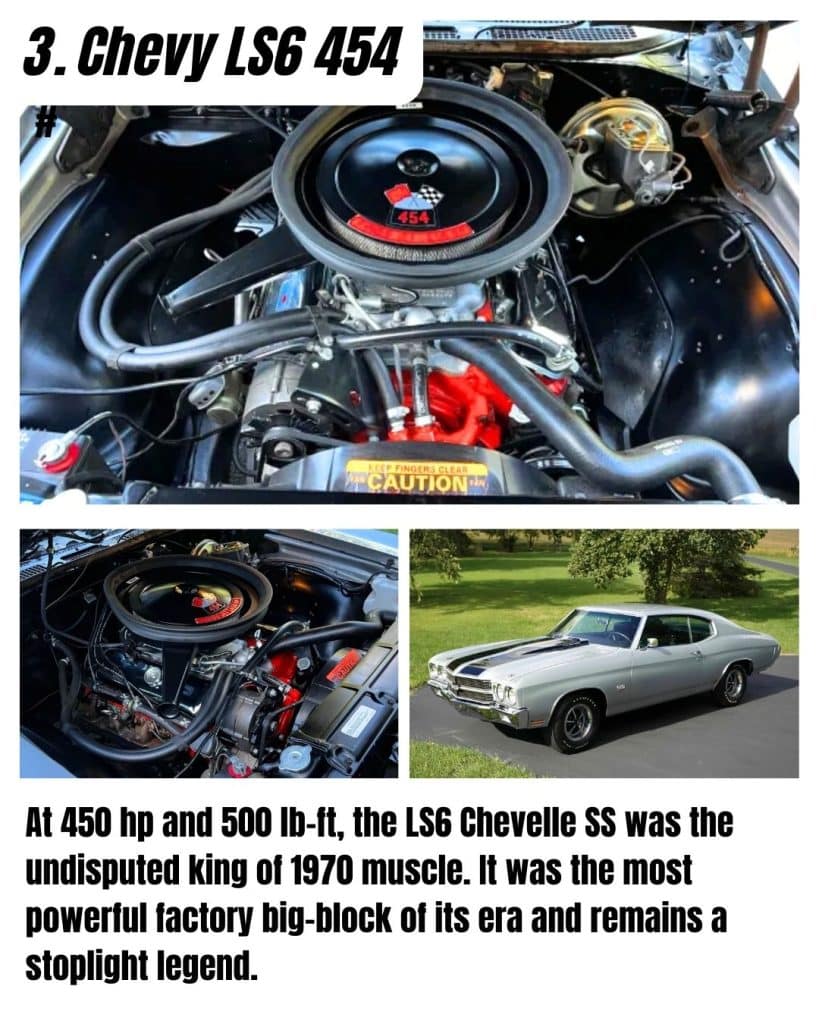
The 454-cubic-inch LS6 was the crown jewel of GM’s muscle car era, officially rated at 450 horsepower and 500 lb-ft of torque.
Found in the 1970 Chevelle SS, it was the most powerful engine you could buy that year and earned a reputation as “King of the Streets,” bludgeoning any challenger at the stoplight with its immense big-block grunt.
Chevrolet LS1 V8 (Gen III, 1997)
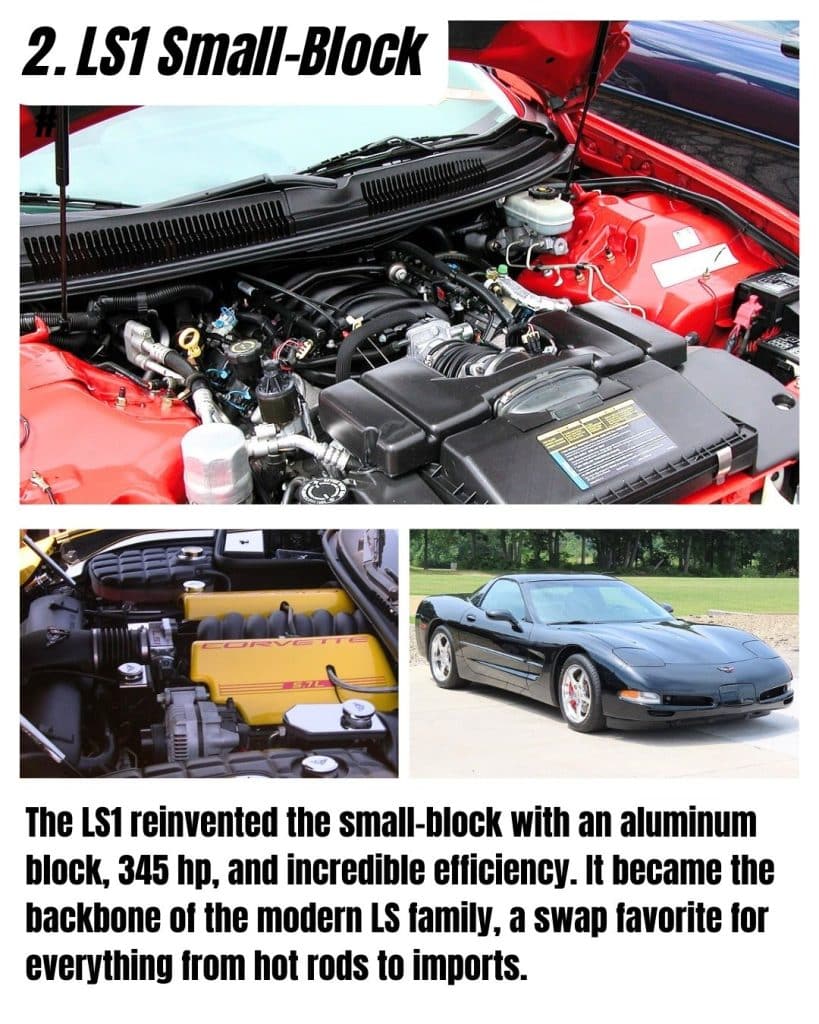
Debuting with 345 hp in the 1997 Corvette, the all-aluminum 5.7L LS1 combined classic pushrod simplicity with modern engineering efficiency.
It was the foundation of GM’s LS-series dynasty – an engine family renowned for its light weight, durability, and enormous tuning potential, evolving into ever more potent versions like the LS6, LS7, and supercharged LS9 in later years.
Chevrolet Small-Block V8 (Gen I, 1955)
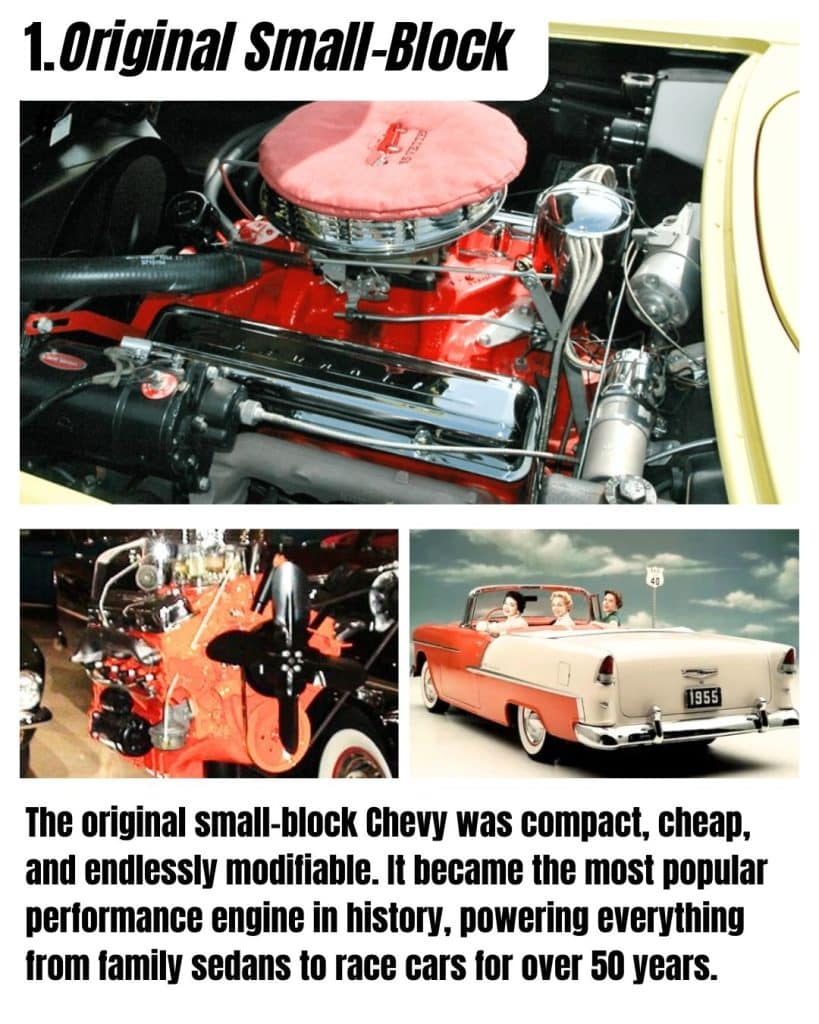
Ed Cole’s 1955 small-block V8 was a lightweight, groundbreaking design that quickly became the darling of the hot-rodding world.
Its compact, high-revving nature and huge aftermarket support kept it in production for over 50 years, powering everything from Corvettes to countless hot rods and winning more races than perhaps any other engine in history.
